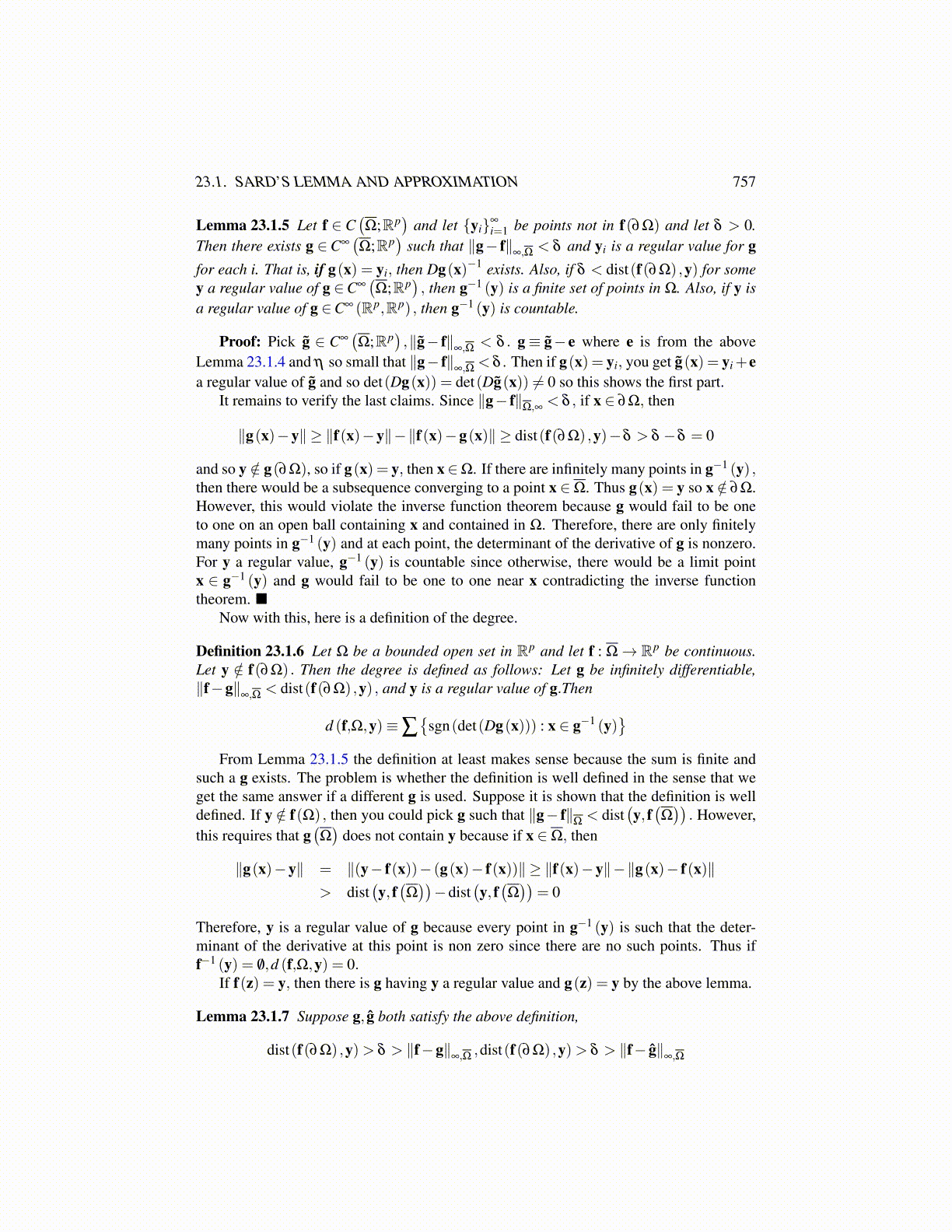
23.1. SARD’S LEMMA AND APPROXIMATION 757
Lemma 23.1.5 Let f ∈ C(Ω;Rp
)and let {yi}∞
i=1 be points not in f(∂Ω) and let δ > 0.Then there exists g ∈C∞
(Ω;Rp
)such that ∥g− f∥
∞,Ω < δ and yi is a regular value for gfor each i. That is, if g(x) = yi, then Dg(x)−1 exists. Also, if δ < dist(f(∂Ω) ,y) for somey a regular value of g ∈C∞
(Ω;Rp
), then g−1 (y) is a finite set of points in Ω. Also, if y is
a regular value of g ∈C∞ (Rp,Rp) , then g−1 (y) is countable.
Proof: Pick g̃ ∈ C∞(Ω;Rp
),∥g̃− f∥
∞,Ω < δ . g≡ g̃− e where e is from the aboveLemma 23.1.4 and η so small that ∥g− f∥
∞,Ω < δ . Then if g(x) = yi, you get g̃(x) = yi+ea regular value of g̃ and so det(Dg(x)) = det(Dg̃(x)) ̸= 0 so this shows the first part.
It remains to verify the last claims. Since ∥g− f∥Ω,∞ < δ , if x ∈ ∂Ω, then
∥g(x)−y∥ ≥ ∥f(x)−y∥−∥f(x)−g(x)∥ ≥ dist(f(∂Ω) ,y)−δ > δ −δ = 0
and so y /∈ g(∂Ω), so if g(x) = y, then x∈Ω. If there are infinitely many points in g−1 (y) ,then there would be a subsequence converging to a point x ∈Ω. Thus g(x) = y so x /∈ ∂Ω.However, this would violate the inverse function theorem because g would fail to be oneto one on an open ball containing x and contained in Ω. Therefore, there are only finitelymany points in g−1 (y) and at each point, the determinant of the derivative of g is nonzero.For y a regular value, g−1 (y) is countable since otherwise, there would be a limit pointx ∈ g−1 (y) and g would fail to be one to one near x contradicting the inverse functiontheorem.
Now with this, here is a definition of the degree.
Definition 23.1.6 Let Ω be a bounded open set in Rp and let f : Ω→ Rp be continuous.Let y /∈ f(∂Ω) . Then the degree is defined as follows: Let g be infinitely differentiable,∥f−g∥
∞,Ω < dist(f(∂Ω) ,y) , and y is a regular value of g.Then
d (f,Ω,y)≡∑{
sgn(det(Dg(x))) : x ∈ g−1 (y)}
From Lemma 23.1.5 the definition at least makes sense because the sum is finite andsuch a g exists. The problem is whether the definition is well defined in the sense that weget the same answer if a different g is used. Suppose it is shown that the definition is welldefined. If y /∈ f(Ω) , then you could pick g such that ∥g− f∥
Ω< dist
(y, f(Ω))
. However,this requires that g
(Ω)
does not contain y because if x ∈Ω, then
∥g(x)−y∥ = ∥(y− f(x))− (g(x)− f(x))∥ ≥ ∥f(x)−y∥−∥g(x)− f(x)∥> dist
(y, f(Ω))−dist
(y, f(Ω))
= 0
Therefore, y is a regular value of g because every point in g−1 (y) is such that the deter-minant of the derivative at this point is non zero since there are no such points. Thus iff−1 (y) = /0,d (f,Ω,y) = 0.
If f(z) = y, then there is g having y a regular value and g(z) = y by the above lemma.
Lemma 23.1.7 Suppose g, ĝ both satisfy the above definition,
dist(f(∂Ω) ,y)> δ > ∥f−g∥∞,Ω ,dist(f(∂Ω) ,y)> δ > ∥f− ĝ∥
∞,Ω